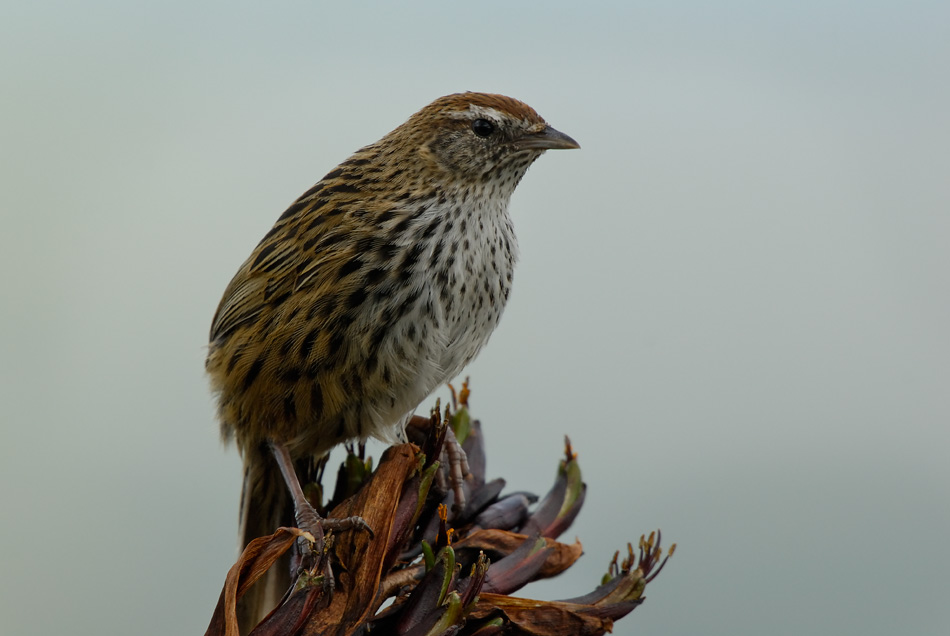Swamp Guardian
Guest blogger: Co-campaign manager for the Fernbird, Anne Fenn
Fernbird (Bowdleria punctata to science, Matata, Kotata or Toetoe to Maori, and swamp sparrow to early European settlers) is truly deserving of the title ‘Bird of the Year’.

Fernbird, Photo: Craig Mckenzie
This bird is unique to New Zealand and spends the large majority of its time in the tangled scrubland of our wetlands.
Indeed, the Fernbird is also one of the few native birds in the list of nominees that tolerates life in saline estuary mangrove areas, although for those whose love goes to high country he has been seen there as well.
He doesn’t claim dominance in the North Island or the South Island, in urban areas or rural areas, as do a number of his competitors, which their campaign managers point to with some sort of pride. Go figure?
His natural home is in them all. From the far North right down to Stewart Island, the Fernbird can be found everywhere. I’ve seen him myself in estuarine wetlands in Auckland, and up in the fields towards Dunstan Range out from Dunedin.
The only thing that changes markedly depending on his whereabouts is the colour of his feathers – lighter or darker brown and red. Fernbird is truly a bird of the people; of the whole of NZ.
That said, the Fernbird is not nearly as common a bird as he once was. Mainly because its wetland habitat fernbird has suffered more loss than most other habitats in our history. People love living on the coast and building on flat areas of reclaimed coastal and wetland areas, and this means displacing the fernbird from his home there. And because fernbird can’t travel any great distance, he can’t just fly away and re-locate.
Nearly 90% of New Zealand’s wetland area has been lost since the early 1800s, and many remaining lakes and wetlands are degraded from the effects of farming: burning, wetland drainage, chemical spraying, and fertiliser runoff from surrounding farmland.
The reason the Fernbird got its name is because it has a fern-like tail, which is reminiscent of a fern frond. Half of the bird’s length is made up of these frayed-looking brown tail feathers, which it droops characteristically when in flight. For such a small bird, the tail is delicate and unique. And pretty darned dramatic. When Tina Turner implored us to shake our tail-feathers, she probably had fernbird in mind.
Fernbirds live in pairs and from their dense scrub habitat typically call out to each other, making a high-pitched, metallic “u-u-u tic, tic” sound. They perform a wonderful-sounding synchronized duet.Combine the dramatic tail and the marvelous duet call, and you’ve got yourself the Elton John and Cher combination of the birdworld!
It mainly feeds on small insects and both parents feed the chicks. That alone should get it a few more votes! Domesticated and shy but hard-working and devoted to his family, mum and dad share the parental tasks. What more could people ask for in bird?
Maori knew the Fernbird as “the wise bird” because of it’s ability to warn them about impending troubles or foretell good fortune depending on how its cry changed (nzbirds.com). The conservation world would be less without this foreteller. Maybe we should have listened to him more, and protected his home better than we have? There is still time to make amends!
We owe the fernbird a huge debt of gratitude too because when government land was being transferred to the then new Department of Conservation, fernbird presence was often the one criterion that allowed wetlands to be conserved. Even now, when an area is under threat, fernbird’s mere presence is enough to draw attention to protect that environment more.
Voting for the fernbird as Bird of the Year is more than just about a bird, it’s about raising public awareness of the unique conservation values of the fragile wetland environments the fernbird lives in.
